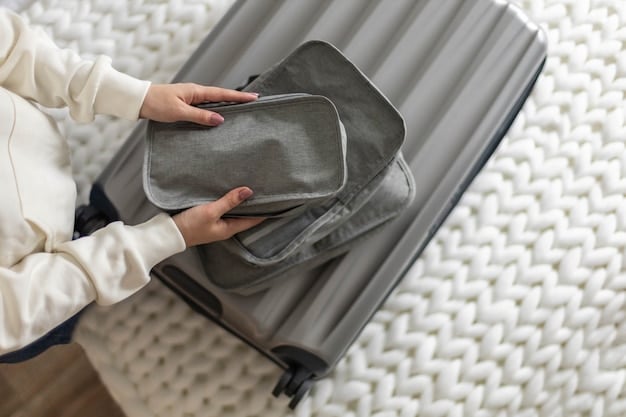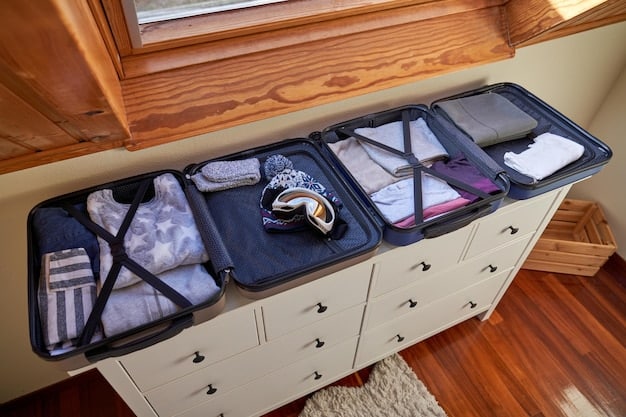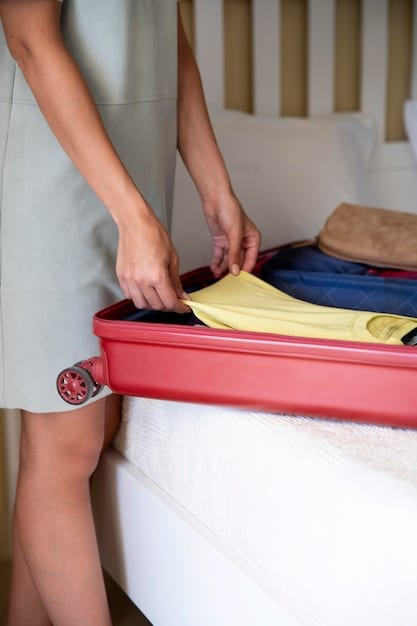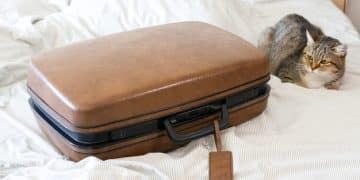The Ultimate Guide to Packing Light: Reduce Luggage Weight by 30%

Embark on a journey of lighter travel with “The Ultimate Guide to Packing Light: Reduce Your Luggage Weight by 30%,” offering expert strategies and practical tips to minimize your luggage load while maximizing your travel experience.
Are you tired of lugging around heavy suitcases on your travels? Do you dream of breezing through airports with just a carry-on? This comprehensive guide, The Ultimate Guide to Packing Light: Reduce Your Luggage Weight by 30%, will equip you with the knowledge and skills to lighten your load and travel smarter.
Why Packing Light Matters
Packing light isn’t just about convenience; it’s about enhancing your entire travel experience. From saving money on baggage fees to reducing stress and increasing your mobility, the benefits are numerous.
Choosing to pack light allows you to explore destinations more freely, immerse yourself in local cultures without being weighed down, and enjoy a more spontaneous and adaptable travel style.
The Financial Advantages of Traveling Light
One of the most tangible benefits of packing light is the potential to save money. Airline baggage fees can be substantial, especially on budget airlines or when exceeding weight limits.
- Avoid checked baggage fees by sticking to carry-on only.
- Save on airport transportation costs by managing your luggage independently.
- Reduce the risk of lost or delayed baggage, which can lead to additional expenses.
The Freedom and Flexibility of Light Packing
Traveling with less luggage grants you the freedom to move around more easily and explore destinations at your own pace. You can navigate public transportation, walk along cobblestone streets, and hop on and off trains without struggling with heavy bags.
Packing light enables to you to stay in a wider range of accommodations, including hostels, guesthouses, and apartments, which may have limited space or require climbing stairs. This gives you more choices and the opportunity to experience travel in new and different ways.
- Enhanced mobility allows for more spontaneous travel decisions.
- Easier to navigate public transportation and crowded areas.
- Greater flexibility to change plans and explore off-the-beaten-path destinations.
Ultimately, packing light is not just about reducing the weight of your suitcase, it can be the secret to a much better travel experience.
Planning Your Packing Strategy
Before you even open your suitcase, it’s crucial to have a well-defined packing strategy. This involves careful planning, making informed decisions about what to bring, and optimizing your available space.
By taking the time to plan your packing strategy, you can avoid overpacking and ensure that you only bring the essentials for your trip.
Creating a Packing List
A packing list is your best friend when it comes to packing light. Start by listing the essential items you need for your trip, such as clothing, toiletries, electronics, and documents. After you have created the initial list of items, you can start marking out any items which are not completely essential or that can be bought at your travel destination instead in order to lighten your baggage.
Consider the length of your trip, the climate of your destination, and the activities you plan to participate in when creating your packing list. Be realistic about what you’ll actually need and avoid packing items “just in case.”
Choosing the Right Luggage
The type of luggage you choose can significantly impact your ability to pack light. Opt for lightweight and durable bags that maximize space and meet airline carry-on restrictions.
Consider a backpack with multiple compartments, a rolling suitcase with compression straps, or a duffel bag that can be easily carried on your shoulder.
- Choose a carry-on that meets airline size and weight restrictions.
- Opt for lightweight materials like nylon or polyester.
- Consider bags with built-in compression straps or organizational compartments.
Planning your packing strategy is an essential step that allows you to be more efficient when packing. You will also benefit from having more space and free luggage.

Essential Clothing Selection
Clothing often takes up the most space and weight in your luggage. Choosing versatile, lightweight fabrics and implementing smart packing techniques can make a significant difference.
Focus on selecting clothing items that can be mixed and matched to create multiple outfits, and prioritize fabrics that are quick-drying, wrinkle-resistant, and lightweight.
Versitle Clothing
Invest in versatile clothing items that can be worn in multiple ways and for different occasions. A simple black dress can be dressed up with jewelry and heels for a night out or worn casually with sandals for a day of sightseeing.
Choose neutral colors that can be easily combined and layered. A lightweight cardigan or jacket can be paired with different tops and bottoms to create a variety of looks.
Fabrics and Materials
Opt for lightweight and quick-drying fabrics like merino wool, nylon, polyester, and rayon. These materials are comfortable to wear, easy to care for, and take up minimal space in your luggage.
Avoid bulky fabrics like denim, corduroy, and leather, which can add unnecessary weight and take longer to dry.
- Merino wool is naturally odor-resistant and moisture-wicking.
- Nylon and polyester are durable, quick-drying, and wrinkle-resistant.
- Rayon is lightweight, breathable, and drapes well.
By being smart about the clothing you take you can save a lot of space and weight. Try to be minimalistic in your approach and only bring items that are required.
Mastering Packing Techniques
The way you pack your clothing can make a significant difference in how much space you save. Mastering efficient packing techniques can help you compress your items and minimize wrinkles.
Experiment with different packing methods to find what works best for you and your style of travel.
Rolling vs. Folding
Rolling your clothes is a popular packing technique that can save space and reduce wrinkles. Roll each item tightly and secure it with a rubber band or packing cube.
Folding your clothes can be more suitable for certain items, such as dress shirts and pants. Fold each item neatly and stack them in your luggage.
Using Packing Cubes
Packing cubes are fabric containers that help organize your luggage and compress your items. They come in various sizes and shapes, allowing you to customize your packing system.
Use packing cubes to separate your clothing into categories, such as tops, bottoms, underwear, and accessories. This makes it easier to find what you need and prevents your clothes from shifting around during travel.

- Compression cubes further reduce volume by compressing air out of your clothes.
- Use different colored cubes to easily identify your items.
- Packing cubes can also be used to organize your items within your hotel room.
The packing techniques you choose will allow you to be far more efficient and make packing much smoother. All these processes help greatly with packing in a way that will reduce 30% or more on luggage.
Streamlining Toiletries and Personal Items
Toiletries and personal items can quickly add weight and bulk to your luggage. Streamlining these items is essential for packing light.
Consider using travel-sized containers, multipurpose products, and solid alternatives to reduce weight and save space.
Travel-Sized Containers
Transfer your favorite shampoos, conditioners, lotions, and other liquids into travel-sized containers. These containers are specifically designed to meet airline carry-on restrictions and are much smaller and lighter than full-sized bottles.
You can purchase travel-sized containers at most drugstores or online retailers. Alternatively, you can reuse empty travel-sized bottles from previous trips.
- Look for TSA-approved travel-sized containers with leak-proof lids.
- Label each container clearly to avoid confusion.
- Consider using reusable silicone travel bottles, which are durable and easy to clean.
Multipurpose Products
Opt for multipurpose products that can serve multiple functions. For example, a tinted moisturizer can replace both foundation and sunscreen.
Consider using a solid shampoo bar instead of liquid shampoo, which can save space and weight and eliminate the risk of leaks.
By streamlining your range of toiletries and personal items, you can greatly reduce the amount of space taken up. This works wonders in trying to reduce luggage weight by 30%.
Leaving Unnecessary Items Behind
One of the most effective ways to pack light is to simply leave unnecessary items behind. Be honest with yourself about what you actually need and eliminate anything that is not essential.
Consider what you can purchase at your destination, borrow from friends or family, or simply do without for the duration of your trip.
Evaluate Every Item
Before packing any item, ask yourself if you really need it. Can you borrow it at your destination? Can you buy it there if necessary? Can you do without it altogether?
Be ruthless in your evaluation and don’t be afraid to leave items behind, even if you think you might need them “just in case.”
Resist “Just in Case” Items
Avoid packing items “just in case” you might need them. These items often take up valuable space and are rarely used.
If you’re unsure whether you’ll need something, consider purchasing it at your destination if the need arises. This will save you space and weight in your luggage.
Leaving behind products that aren’t completely necessary is a key factor in reducing 30% or more luggage weight. Being strict on yourself can reap great benefits when packing.
| Key Point | Brief Description |
|---|---|
| ✈️ Planning and Strategy | Careful planning saves significant space by selecting only essential items. |
| 👕 Clothing Selection | Versatile and lightweight fabrics reduce bulk while maximizing outfit options. |
| 🧳 Packing Techniques | Efficient methods like rolling and packing cubes compress items and prevent wrinkles. |
| 🧴 Toiletries | Travel-sized and multipurpose toiletries significantly reduce luggage weight. |
FAQ
▼
Lay the item flat, fold in the sleeves, then tightly roll from the bottom up. Secure with a rubber band or place in a packing cube to maintain its shape.
▼
Rolling clothes tightly helps minimize wrinkles. Also, place delicate items inside a dry cleaning bag to prevent friction and creases during transit.
▼
Include travel-sized versions of toothpaste, toothbrush, shampoo, conditioner, and sunscreen. Consider solid alternatives like shampoo bars to save space and avoid leaks.
▼
Check the airline’s specific size and weight restrictions for carry-ons. Measure the bag’s dimensions and weigh it before traveling to avoid issues at the airport.
▼
Yes, most airlines allow a personal item like a purse, laptop bag, or small backpack. Use this extra allowance to carry essentials like electronics, medication, and documents.
Conclusion
By following these tips and strategies, you can significantly reduce your luggage weight and enjoy a more streamlined and stress-free travel experience. Packing light is not just about convenience; it’s about embracing a minimalist travel mindset and maximizing your adventures.





